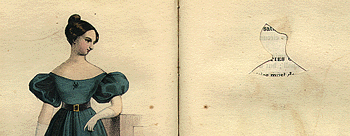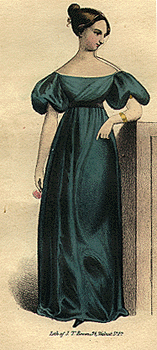 Q Dear Miss Abigail:
Q Dear Miss Abigail:
What do you suggest that I can wear to my senior prom? I’m 1.76m and 50kg, but kinda flat and thus relatively heavier on the bottoms.
Signed,
Natalie
A Dear Natalie:
Hmm…if I were to translate those dimensions into “American” terms, lets see, you would be…um…well, in any case, I think I can help with the flat chested/heavy bottom problem. I’ve been dying to use an excerpt from this 1840s book given to me by a friend. Female Beauty, written by Mrs. A. Walker, has a much longer title than I can possible fit here. It is also completely falling apart (there is a huge chunk missing from the middle, unfortunately), but what I do have is wonderful. Make sure you look at the illustrations (below) ~ you won’t regret it!
1840: Peculiarities of Shape, &c.
![]() Many peculiarities must depend upon fashion; but still more on the style of the figure.
Many peculiarities must depend upon fashion; but still more on the style of the figure.
Tall thin women may wear a great deal of clothing, or loose flowing drapery, bright coloured dresses of silk, and several rows of trimming; whilst short stout women will appear to the greatest advantage in dark coloured gowns close to the shape of the body, and merely easy in the skirt, with very little trimming, &c.
Apparent width may be given to narrow shoulders, by having the epaulettes of the dress, when epaulettes are worn, very full on the extremity of the shoulders, and the bosom and back of the dress running in oblique folds, from the point of the shoulder to the middle of the bust.
A waist which is neither long nor short, neither compressed unnaturally above nor below, will always be most agreeable to the enlightened and cultivated eye; while it will, at the same time, give the power of adjusting the dress in the most graceful manner. On such a waist, dresses disposed in the stomacher form may be very happily adopted, or the full plaitings of the blouze disposed to advantage. In either case, if the waist is but even a little too long, the line of beauty is lost, and that loss will not be compensated by the mere circumstance of being slender.
A long waist is unbecoming to a short figure, where the bosom is small; but where there exists considerable plumpness and fulness, the waist should have its natural length.
If the hips are large and high, the body of the dress should be long, whatever the stature.
By wearing the dress full at the shoulders and at the hips, the waist will by contrast appear smaller; and this is a much better plan than tight lacing.
If the waist still appears thick, a stomacher in front will further relieve it; and, behind, the dress may be plain and wide across the shoulders, and drawn in gathers to a narrow point at the bottom of the waist. ~ See Plate IV [below]. where, though the waist is not naturally too thick, it is further reduced by such means.![]()
Female Beauty is blessed with having beautifully colored illustrations, depicting, as far as I can tell, the “before” and “after” pictures of young ladies in certain fashion dilemmas. I scanned a two-page image of the book to show you what it’s like ~ notice the cutout on the page on the right.

This allows you to flip back and forth. Bad, good! Bad, good! Oooh, lovely! Now, I must admit that I had a bit of trouble figuring out which was the “good” version, and although I thought it was the one on the right (below), friends consulted insist the better dress is the one on the left. And the caption for the one on the left, by the way, says “Management of Thick Waist,” crediting J. T. Bowen of 94 Walnut Street in Pennsylvania with creating the lithographs, so they must be right.


Source: Walker, Mrs. A. Female Beauty, as Preserved and Improved by Regimen, Cleanliness and Dress. New York: Scofield and Voorhies, 1840.
~ pp. 331-32 ~